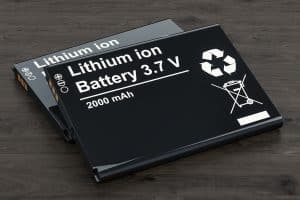Handle with care: lithium-ion battery risks and safety tips

Lithium-ion batteries cause approximately 15 to 20 fires a year, according to Ben Muller, an area officer for West Kimberly at fire and emergency services. In February 2022, a fire caused by a lithium-ion battery in northern Adelaide caused over $200,000 in damage, reigniting safety concerns surrounding the handling, storage, and disposal of these batteries. Fires sparked by lithium-ion batteries are almost impossible to extinguish with no specific solution on the market. Currently, the best cause of action is to drown the fire with massive volumes of water; however, some fires can burn for hours, even days, and have even been known to burn underwater.
Justin Morris, Technical Director, Wormald, said, “The dangers of lithium-ion batteries shouldn’t be underestimated as they are extremely sensitive to high temperatures and inherently combustible. A lithium-ion battery-induced fire is self-sustaining and can’t be easily extinguished with traditional fire extinguishing systems and methods. Understanding lithium-ion batteries and handling them with the utmost care is the best way to mitigate the risk of fire, which can cause widespread damage.”
There are five simple steps that people can take to prevent an incident involving lithium-ion batteries:
1. Keep lithium-ion batteries at room temperature
Temperature affects lithium-ion battery performance, safety, and cycle lifetime. When a battery is fully charged and stored in higher-than-average temperatures, it will reduce the battery life and increase the risk of catching fire. When lithium-ion batteries are stored in cold temperatures, devices such as mobile phones will need frequent charging, and electric cars will have shorter driving ranges. For best results, lithium-ion batteries are at their safest when stored between 5°C and 20°C.
2. Avoid overcharging devices
When lithium-ion batteries are overcharged, they can create unstable conditions inside the battery and cause thermal runaway. This chain reaction occurs when the internal temperature heats up uncontrollably. Leaving an over-charged device in the wall socket increases the risk of damage to the battery and creates a fire hazard. Instead, avoid overnight charging and minimise the time the battery spends at either 100 per cent or zero per cent charge. Keeping the battery partially charged and letting it reach 50 per cent before recharging it again is an effective method of mitigating the risk.
3. Avoid mishandling lithium-ion batteries
A punctured lithium-ion battery can cause a short-circuit or leak potent electrolytes through the hole, creating a chemical reaction that releases heat. This heat can damage other battery cells and may burst or explode. It can also irritate the skin, nose, and throat hours after exposure and may cause a severe burn. When handled properly, lithium-ion batteries are safe during use and storage and will have a long battery lifecycle.
4. Keep lithium-ion batteries clean
Lithium-ion batteries seem to attract dirt, dust, and grime. Keeping them clean will reduce the likelihood of a fire and optimise battery performance and storage capacity. For mobile devices, use a cloth to clean around the vents and ports regularly to avoid dust build-up.
5. Only purchase lithium-ion batteries from reputable manufacturers
To prevent the risk of short circuits or power surges, it’s important to buy lithium-ion batteries from approved manufacturers. Counterfeit lithium-ion batteries appear bona fide; however, they are likely made with inferior materials and may not be listed to any safety standard. For peace of mind, check the Australian government’s Electrical Equipment Safety Scheme (EESS), a set of requirements that manufacturers must meet to sell electrical equipment to Australian consumers.
Should a lithium-ion battery ignite, it’s possible to cut off the current supply by flooding it with water; however, given the highly flammable nature of the battery, it’s best to immediately leave the location and call for assistance, depending on the severity of the situation. In almost all cases, prevention is better than cure. Following recommended practices is an effective way to minimise the risk of lithium-ion battery fire and the potentially devastating consequences that come from it.
For further information on lithium-ion batteries and avoiding fire risks, contact our team on 133 166.

